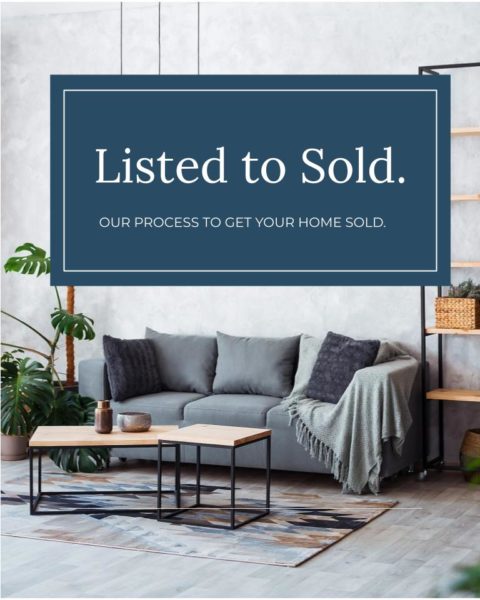
Real Estate Listing Presentation – How to Create the Perfect One
- 29 Mar 2021
- Real Estate Marketing, Real Estate Social Media
- agentcrate
You’ve done it — you secured a meeting to pitch your real estate agent services to a prospective seller client. The next step is to create a winning real estate listing presentation that sells.
Whether you’ve done hundreds of listing presentations or not, this step in the interview process is significant. So making a listing presentation shows your prospective clients that you have their best interest in mind while also demonstrating your knowledge about the field is crucial for your success as a real estate agent.
But of course, this is all easier said than done. That’s why we put together a list of our top tips on how to create a real estate listing presentation that is guaranteed to make a lasting impression on any type of seller.
#1 – Include an About Me or About Us page
Real estate listing presentations can be very formal, but there is no reason that you cannot add a little bit of personality to yours. An about us page allows sellers to get an idea of who they will be working with if they choose your selling process over the other options on the market.
If you do not have an about us page, now would be the time to create one or utilize the one already written off of your website and include it in your listing presentation so that potential clients can learn more about you before they sign with you. You want sellers to feel comfortable working with you, and an about us page will help to achieve this goal.
#2 – Include Testimonials from Past Clients
It is always a good idea for real estate agents to include testimonials from past clients in listing presentations. Not only does this give the audience members an opportunity to see what other people who have worked with you thought of your listing presentation, but it also provides social proof that will make them more likely to choose you over another agent or company.
Including some testimonials in your presentations can help real estate agents back up the statements you’re claiming. Sellers feel most comfortable when they know they’re going to work with a true professional who has a good track record.
If you’re relatively new to the game, find other ways to strengthen your pitch by showing projects you’ve worked on in the past or even blog posts/podcasts/news channels you’ve been featured on.
If you can, including hard data can also be a form of social proof. For example, do you sell 40% faster than your competitors or are you able to secure deals that are 10% higher than the listing price? Go ahead, show off your skills with evidence!
Testimonials from past clients will help to increase your credibility as a real estate agent, and listing presentation testimonials can even be included on business cards or other promotional material so that you have them available for future use.
#3 – Explain the sales process
An explanation of its use can be useful for a very first-time seller when selling a product or service. Explaining how home a home sells and costs can help people navigate their way through the process and set clear expectations of the complete process to sell their home from the beginning.
The more owners know behind the scenes of the business the better a relationship they have with the right person.
#4 – Include Local Market Statistics in your Listing Presentation
Your listing presentation and pricing strategy should never be created in a bubble. In order to effectively sell your listing, you need to know what is going on around it and how that will affect the way that people view it.
Including market statistics from the area of your listing as well as throughout the country can help give potential sellers context for why your listing price might go up or down.
People do not like to make decisions without information, and your presentation should be designed with that in mind. You want potential sellers to feel informed and confident about the listing presentation you are offering them so that they will choose your services over those of other agents to sell thier home.
#5 – Include Your Personal Sales Statistics
Do you sell your listings for 95% of their original list price? If so, your listing presentation should include this information. It can be beneficial to potential clients if they know that you are skilled at negotiating with sellers and getting listings sold for the best possible price.
Those looking to sell their home will appreciate knowing how good of a negotiator you are before signing on with an agent and listing presentations allow them to get this information. It is important to include your listing presentation statistics so that potential clients can see what you have done in the past and how good of an agent they will be working with if they choose you over someone else.
#6 – Outline your pricing strategy
The crux of any real estate listing presentation is price strategizing strategy. This can be a good opportunity to illustrate how pricing their home correctly the first time could save them money in the long run. Rather than overpricing and missing out on a huge buyer pool.
When real estate agents are explaining pricing strategies be sure you show how aspects like square footage, updating numbers of bedrooms, overall features, and market fit affect local pricing. Do what is necessary to help the homeowner understand how pricing works and how you approach what you do for the best result. This area of the presentation may be one of the most important and impactful.
#7 – Include a Comparative Market Analysis (CMA)
A listing presentation should never be without a comparative market analysis (CMA). A CMA is basically a breakdown of all of the listings in your area and how they stack up to one another. It helps potential buyers or sellers get an idea about what homes are selling for throughout the community so that they can make informed decisions about listing prices.
You want listing presentations to include a comparative market analysis so that potential clients can feel confident in their listing price and what they are offering.
A CMA provides context for the listing presentation, which makes it easier for buyers or sellers to make decisions about properties when presented with hard numbers instead of just opinions.
If you’ve never created a CMA before ensure you ask your broker or a colleage for guideance.
Pro tip: Agentcrate members get access to our free CMA guide as well as other guides agents love to use as a free resource for themselves or thier clients.
#8 – Present Your Overall Marketing Strategy

This tip goes along with the one above in terms of setting yourself apart from the competition, but we decided to give it its own spotlight due to how crucial marketing is in today’s era.
Showing your clients that you understand online marketing in addition to traditional print marketing is a huge plus since nine out of ten home buyers turn to the internet as one of their primary research sources, according to the National Association of Realtors. For demonstration purposes, you could give a preview of your marketing strategy and some analytics from previous clients.
This can include your professional photography, staging ideas, social media syndication outlets, your paid marketing strategy, how you followup with leads and so on.
Social Media Strategy
Include a social media strategy in your presentation if you have one. Potential buyers and sellers will appreciate knowing what they can expect from the agent that is representing them throughout their listing process, and some of these things may include regular activity on social media sites such as Facebook or Twitter. People want to work with agents who are active on social media, so listing presentations should include your social media strategy.
For example, do you run Facebook or Instagram ads for each listing you receive? How many leads do you normally receive from these ads? What budget do you set aside for them?
Print Marketing Strategy
Include a listing presentation marketing strategy that includes print media. While social media is great for getting the word out about listings, print materials can be beneficial in different ways. For example, you may want to include handouts for open houses so that people have them available when they are going through potential properties and trying to make decisions about which one to choose. Or you do postcard campaigns to get the word out about a new listing in a local market neighborhood.
Print listing presentation materials can be helpful when it comes to getting the word out about listings, so make sure your listing presentations include print marketing strategy information as well as social media and online information. It will help potential buyers or sellers feel more informed about what you are offering them in terms of support throughout their process!
How do you use your website?
Most homeowners will find the value of having an online presence to be quite high. Discuss how many times your website is visited and how effectively it functions with traffic and revenue. It should be clear that IDX provides a listing option for not just their own sites, but also those of other brokers with IDX sites.
If you have a few of unique property websites that you created for other listings, this is an excellent moment to promote them.
#9 – Talk about what will happen when the listing goes live.
Discuss online opportunities to sell and show homes while giving time for your question as well. It’s a fantastic time to highlight your service by outlining how often you’ll be in contact with them for updates and feedback. Make them aware you’re available for their inquiries if they have any doubts about their home on the market.
Which type of communication prefers them and why? Do they like texting or calling? How do these people interact with you? Take a minute with the experienced sellers in these sectors.
#10 – Processes for Followup and Feedback
Include a listing presentation process that is designed to help potential clients feel informed and confident about their listing agent. This may include information on how you will be following up with them after the listing has been listed or steps they can take if there are any problems throughout the listing period.
Include information about feedback in your listing presentations as well. This can be beneficial because it helps potential sellers feel more confident, and listing agents can also use feedback to improve their services.
For example:
-I send out emails and texts after each showing or open house to obtain feedback and send you a weekly report
-I have each open house visitor complete a feedback form
Make sure your listing presentations include information about follow-up, final steps, and feedback so that buyers or sellers feel more informed about the listing process.
#11 – Discuss Hosting Open Houses in Your Real Estate Listing Presentation
Include information about open houses and showings in listing presentations. Potential buyers or sellers will want to know how often the listing agent is going to be hosting these events, so it’s a good idea to include this in your listing presentation materials.
You may also want to discuss what people can expect at an open house, such as the layout of the house and what they should be looking for when it comes to preparing their home for an open house.
For example:
-I host two open houses per month!
-During an open house, clients can expect a tour of their home with information about available features as well as showings from potential buyers or renters interested in seeing their listing on the market.
-I provide print materials in open house visitors to help people gain a better understanding of the home features.
#12 – Home Staging
Listing presentations should include information about home staging as well. Staging can help potential sellers feel more confident about listing their property on the market. This will be useful for people who want to learn more about whether they could benefit from home staging services.
Whether you offer staging services as part of your service or selling process, or simply provide the client with a staging checklist – it is a great idea to go over any thoughts you have regarding staging and if you feel it would benefit your seller to consider.
#13 – Ask Questions about the Property
Include questions about the listing property in your listing presentations. This will serve to show buyers or sellers that you are informed and invested, which can make them more likely to consider using your services as their listing agent!
-Do you know what style of architecture this home is? (wooded colonial) If not ask a question like “What style of architecture would you say this listing property is?”
-Do you know what the monthly HOA fees are for this listing? If not ask a question like ” What do you think are reasonable HOA dues for a listing in this area and why?”
What improvements have you made to the property?
These questions show your client that you have done some research on their listing and that you are interested in listing their property properly.
#14 – Posture and body language are important
Your posture position, your shoulders position, and your overall expression will communicate a lot more than what you’re saying.
-Stand or sit tall and straight with shoulders back
This shows that you are confident in your listing presentation skills. It also helps buyers and sellers feel more comfortable when they’re working with a listing agent who seems knowledgeable about their listing property’s needs as well as the process of selling the home.
Mirror the clients body language. If they are leaning forward, doing the same will help them feel more comfortable with you.
Never cross your arms or legs when speaking with someone because it can make you seem closed off to what they are saying.
This shows that you’re trying to remain open and positive. This will also help buyers and sellers feel more comfortable when it comes time for them to ask questions about their listing as well.
#15 – Prepare for objections and lots of questions.
Some of your leads may ask a lot of questions a lot during the presentation. Each question teaches you the best ways to demonstrate your skills, value proposition and develop trust.
Of course, there may be questions you could never anticipate. Give straight answers without feeling obligated if you don’t have the answer at the moment. Simply answer, “I’ll be happy to look into that for you”.
If you think you would be better at writing an email to the sellers to answer more detailed questions after the presentations, let them know that you can send them an email follow-up.
#16 – Be optimistic, but also realistic
It’s always a good idea to be optimistic in meetings to get clients excited about working with you — but when it comes to selling your services and/or your brokerage, it can be easy to get lost in the enthusiasm. Too much enthusiasm has the ability to cloud judgment and result in false promises. This is why it’s crucial to also remember to be realistic.
You can achieve a balance of both by setting clear expectations about what is included in your services and what your commission is so the sellers know exactly what they’re getting into. Being open, honest, and transparent like this can be awkward or unnerving, but it will save everyone a headache as you sign the contracts.
#17 – Listen to the sellers’ goals during your real estate listing presentation

Sellers are most likely looking for a real estate agent who can create a plan that aligns with their goals — it makes sense, right? Not every seller or house is the same, so one strategy can’t be applied to all your clients. It’s crucial to listen to them during the meeting or a consultation call, and then shape your presentation around what they are hoping to get out of working with you.
#18 – Double-check the data in your listing presentation
While conducting research for your listing presentation, fact-check all your data to make sure that the information you will be presenting is correct. Even if you don’t think your sellers will know the exact numbers and statistics, the real estate industry can be volatile at times. It’s in your best interest and your client’s best interest to avoid any major surprises along the house-selling journey by being as accurate as possible.
Also, if your presentation is delayed for any reason, it’s best practice to go back and update any data you include in your presentation. This is just another way of how you can stand out from the competition by showing that you’re willing to go the extra mile to stay up-to-date on market changes.
#18 – Be prepared with the details
This may seem like a no-brainer, but we had to remind you to best prepare you to create a killer presentation. Going into a meeting with your potential client and being fully prepared guarantees a professional appearance and competent performance, which not only helps your prospective clients feel secure in their choice but it also boosts the reputation and success of your business.
#19 – Practice with real people
It may seem tempting to memorize your presentation alone. But once you have your presentation down pat, try it out on others for feedback. A trustworthy colleague can help improve efficiency.
Friends/family who are not in the field can alert you to any industry jargon you have to explain. Presentation to a crowd also helps build your confidence. Tell your test audience to stop and pose questions and be demanding.
Pro Tip: People love to see what they want, so if you give them several options (such as listing price range or price reduction strategy) and ask which one they feel is best for them, they will feel more in control and open up the topic for further discussion.
#20 – Analyze all information leads provide you before your pitch.
Most of the time, the home sellers will have additional information that they give you prior to the meeting. Some may provide information when they plan on listing and what their home’s price should be. Make sure to address these items at your listing appointment.
#21 – Don’t be a “yes” agent just to win new business.
All businesses have someone saying yes but there’s no chance that they’ll become a real buyer client. Be upfront with your sellers regarding your expectations of the whole process of home selling.
Do not nod in approval of every request and every mandate. This could lead to unfilled promises in the sales process which then cause your client to question your methods at work or even fire you.
Do an honest job and give a fair idea about what you expect in your customers through your entire sales process. Your goal at the listing appointment is not just to the listing, but to list at a reasonable and fair price that you feel the home can actually sell for.
#22 – Handle Objections
Every listing presentation is a chance for you to find out what your customer really wants. Some people have in mind how they want their listing or home represented in the market place and if it doesn’t match up with what you do, this may be a problem.
If so ask questions about why they feel that way. For example: “What are the most important things you are looking for in a listing agent?” “What are some initial concerns you may have?”
Ask questions about what they expect from the listing presentation and how it will benefit them in order to help their house sell quickly. An effective closing question is one that asks for action, not just another pause.
#23 – Leverage the Power of your Brand
Your listing presentation is an opportunity to create a strong personal brand. Your listing presentation must be consistent in order for your image and future sales prospects to build trust with you in this way. A listing presentation is a marketing tool that can be used to build an agent’s brand and increase sales.
Are you the #1 Agent in your brokerage? Have you sold $100 million in sales this year? Don’t be a secret agent and make sure you include your strong brand attributes and highlights in real estate listing presentations.
#24 – End With a Call to Action
Make sure at the end of the listing presentation you ask for the sale. Perhaps you ask, “Are you ready to list today?”.
If you are not listing today then end the meeting by asking when the best time to followup up with them may be or perhaps some other details about their home before you both leave.
#25 – Always say thank you
Always remember to say thank you at the end of the listing presentation. This shows appreciation and gives validation to your listing presentation.
You can also ask people what they think of the listing presentation before you go.
Thank them for their time and help them start thinking about listing if they haven’t signed yet.
Bonus tip: Listing Presentation Templates

Use a Template to create a listing presentation
Use an application or template that already has listing presentation content. You will be able to upload your own images so that they can be included in your listing presentations. These listing templates generally have a variety of different slides or pages, which means that you will not need to come up with all of the listing presentation content yourself – a huge time saver!
A template makes it easy to create listing presentations because all of the information is already written and ready to go. You will not need to worry about writing out each slide from scratch. This means that you can make a listing presentation much more quickly.
PRO TIP:
But we’re not quite done yet! As a pro tip, we wanted to remind you that creating a presentation that is easy to read is just as important as remembering the tips above. Need some help designing without spending hundreds of dollars on a designer? Agentcrate has got you covered.
Our Standard Membership comes with easy-to-use and customizable listing presentation templates so you can focus on what matters most — attending to your clients. A real estate listing presentation is a crucial part of any real estate agent’s job, and it can make the difference between getting a deal or losing one. These presentations are how agents will show potential buyers their listings and convince them to purchase. In this blog post, we will discuss what you need to include in your listing presentation as well as some tips for making sure that your presentation is perfect.
Sign up for Agentcrate and get immediate access to our gorgeously designed real estate listing presentation templates!
Final Thoughts
***In conclusion, listing presentations are a great way to highlight the property you have for sale. They allow buyers and their agents an opportunity to quickly view important listing information, which can save them time from contacting you or coming out to see the listing themselves. Creating templates for these presentations will guarantee that you convey all of the information in a professional and high-end style, giving you an advantage over the competition.
